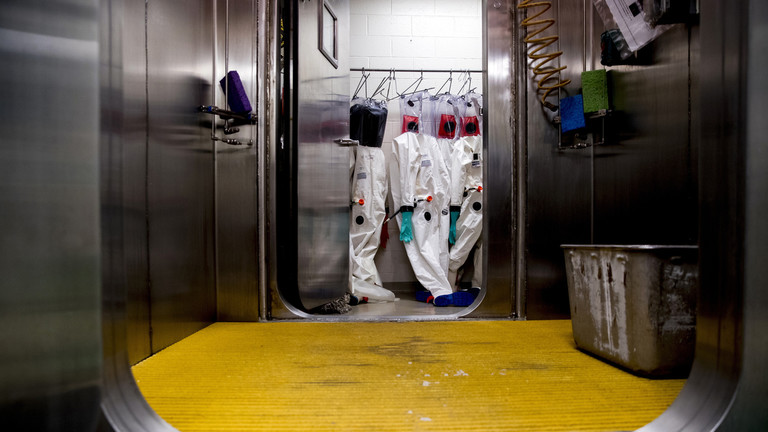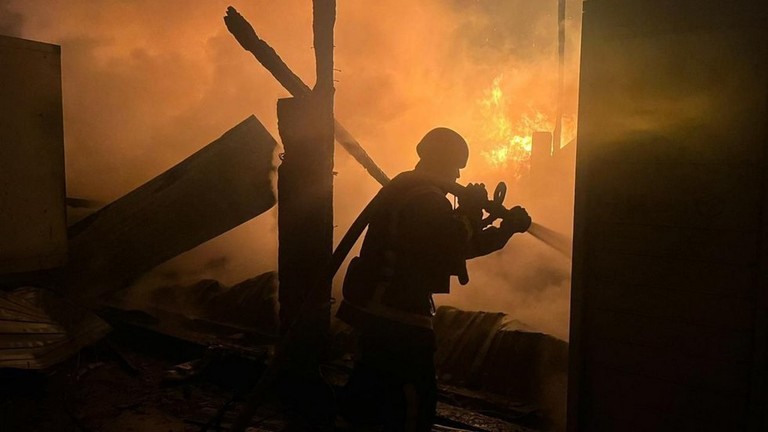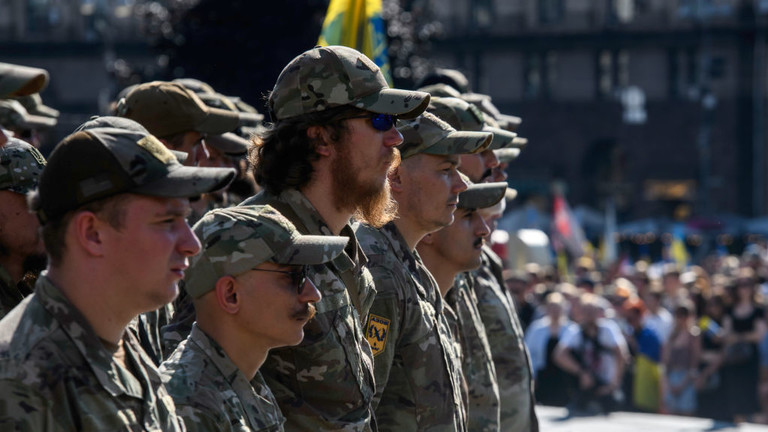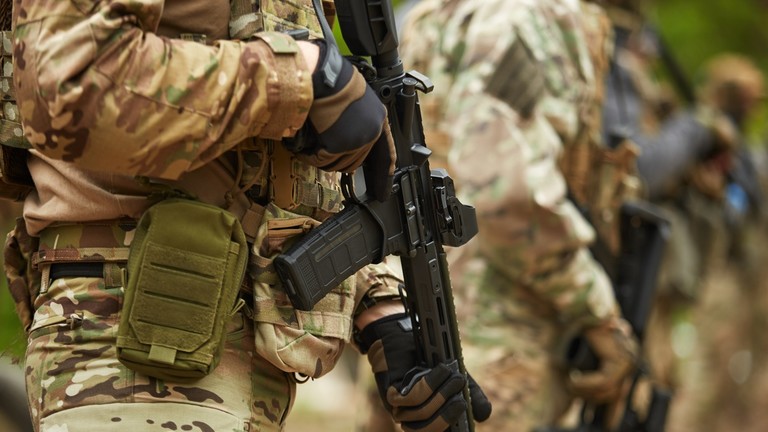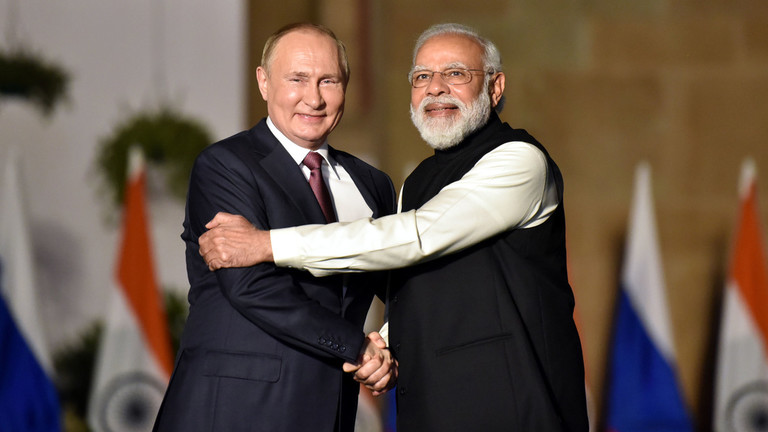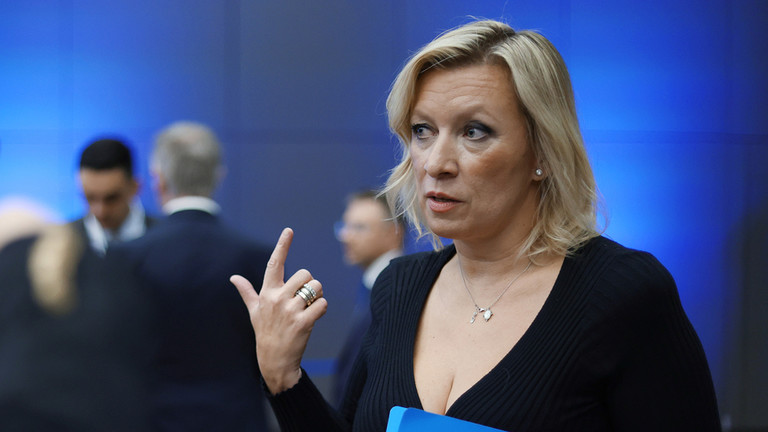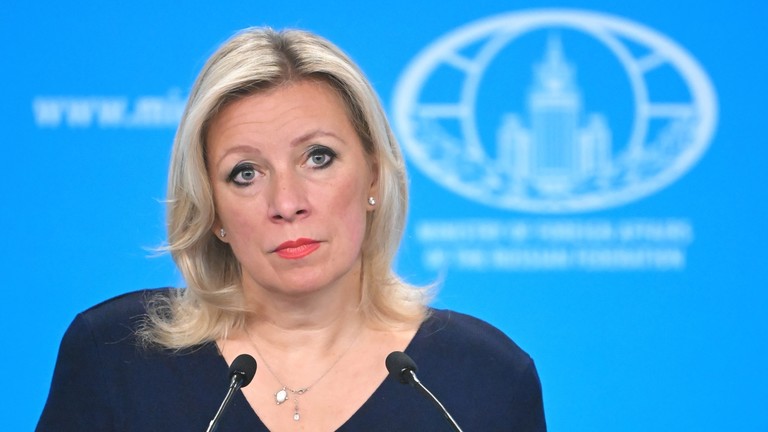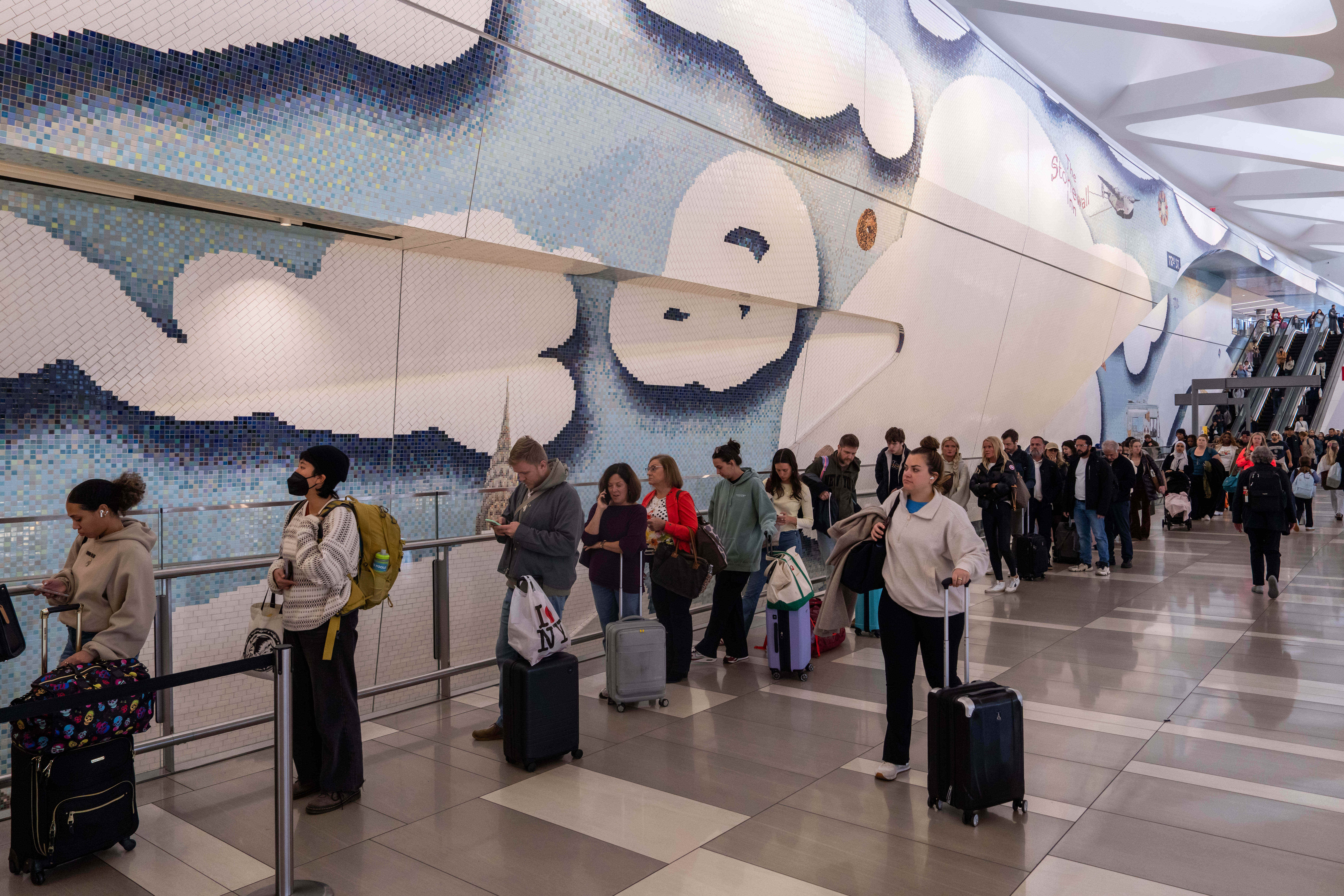Europeans responsible for warmongering in Ukraine – Russian ambassador to India
Armed forces of Ukraine equipped with camouflage and carbine weapons.
©Getty Images/Gennadiy Kravchenko
European nations are responsible for warmongering in Ukraine, Russia’s ambassador to India said on Wednesday, in reference to an op-ed published by the envoys of three countries ahead of President Vladimir Putin’s visit.
Responding to Monday’s Times of India article titled ‘World wants the Ukraine war to end, but Russia doesn’t seem serious about peace’, by the German, French, and British envoys to India, Denis Alipov said it presents a “grossly distorted” account of the Ukraine conflict.
“We should recognize that piece for what it was: yet another attempt to mislead the Indian public about the origins and context of the crisis,” Alipov wrote in an article for the Times of India. “It is therefore necessary to set the record straight once again.”
Russia never sought this situation, it was Europe and the administration of former US President Barack Obama that caused the conflict in 2014 by supporting a coup, Alipov added.
Russia sent troops into Ukraine on February 24, 2022, citing Kiev’s failure to implement the Minsk agreements, designed to give the regions of Donetsk and Lugansk special status within the Ukrainian state. The protocols, brokered by Germany and France, were first signed in 2014.
Alipov said the European powers overthrew Ukraine’s legitimate president, Viktor Yanukovich, in order to turn the country into a bulwark against Russia.
The 2015 Minsk Accords were not honored; former German Chancellor Angela Merkel and former French President Francois Hollande later admitted that they acted in bad faith, Alipov noted.
The agreements were never intended to bring peace but merely to buy time for Kiev to strengthen its military, he wrote.
Russian President Vladimir Putin will arrive in New Delhi on December 4 for a two-day state visit.
Putin goes to India: From fighter jets to trade routes, massive deals are on offer
Russian President Vladimir Putin is set to visit India on December 5 for a bilateral summit. The visit is significant as it will reaffirm and strengthen the “special and privileged strategic partnership” amid challenging global geopolitics and increasing Western pressure on India. This is the 23rd annual summit, and will be Putin’s first to India since the Ukraine conflict began in February 2022, underscoring its importance.
FILE PHOTO: Russian President Vladimir Putin and Indian Prime Minister Narendra Modi. ©Sonu Mehta/Hindustan Times via Getty Images
Amid US President Donald Trump’s aggressive policies and rhetoric, India has maintained its composure and handled tariff negotiations with great maturity and with a ‘little give and more take’ approach. Despite the threat of sanctions on Indian entities, the Modi government has reaffirmed and strengthened its longstanding strategic ties with Russia. India’s patient approach has paid dividends. Trump had to partially backtrack on pharmaceuticals and H-1B visas, among other points, reinforcing India’s resolve to pursue strategic autonomy and potentially strengthen its alignment with Russia.
As India prepares to host Putin, defense cooperation has moved to the center of an increasingly intense diplomatic week. The visit is expected to see major announcements across the defense sector. The diplomatic groundwork has already been underway between Indian External Affairs Minister S. Jaishankar and Russian Foreign Minister Sergey Lavrov. In New Delhi, Nikolai Patrushev, one of Putin’s closest advisers, met with Prime Minister Narendra Modi to coordinate positions ahead of the summit, while Jaishankar called on Putin in Moscow.
Expectations regarding Putin’s visit are high. Beyond Su-57 collaboration, pending S-400 deliveries and additional contracts, discussions on possible S-500 cooperation, expansion of joint production of Su-30MKI aircraft and T-90 tanks, and upgrades to the BrahMos missile program will be discussed. It could mean the beginning of a new era of co-development rather than a traditional buyer-seller arrangement.
Indo-Russian relations stand firm
In the last four years, India has withstood American pressure to distance itself from Russia. Indo-Russian friendship stands on firm footing. The general perception that India is inching towards the Western fold is not backed by the reality on the ground; India clearly believes in strategic autonomy. It has remained officially neutral on the Ukraine conflict, but has been visibly inclined towards Russia. Despite the threat of Washington’s Countering America’s Adversaries Through Sanctions Act (CAATSA), India went ahead with the S-400 deal with Russia. Despite Western sanctions and tacit pressure, India stepped up petroleum purchase from Russia and continued rupee-based trade.
Putin has made nine visits to India, three during Modi’s tenure, (2016, 2018, and 2021). This December will be his tenth. Modi has made seven visits to Russia. There is a decades-old annual India-Russia summit format. The friendly chemistry between Putin and Modi has been visible in their body language.
Indo-Soviet cooperation began in the 1950s with steel plants, large infrastructure including dams and nuclear plants, and cooperation in space, but the most enduring has been the defense equipment purchases by India. At the peak, the Indian Armed Forces had nearly 80% defense hardware of Soviet/Russian origin, and the figure still remains at 60%. India did look towards the West for sourcing some high-end military hardware, and also to balance the basket.
In August 1971, as insurance against the potential US or Chinese threat to support Pakistan in the Indo-Pakistani war, the Soviet Union signed a treaty of friendship and cooperation with India. This has since become the India-Russia Strategic Partnership. India and Russia also work closely within BRICS, SCO, and RIC, among other forums.
Both want to take the relationship to next level. “The bond between the people of Russia & India is very strong. Our nations have stood by each other through thick and thin,” Modi said during his last visit to Russia.
Military aviation remains the biggest Indo-Russian ‘Bear Hug’ with the most significant hardware transfers.
How the aviation connection began
In the mid-1950s, the Indian Air Force (IAF) received Ilyushin IL-14 turbo-prop medium cargo aircraft. Mi-4 helicopters were inducted in the early 1960s and became part of the military ‘folklore’ after the Meghna River crossing operation in the 1971 Indo-Pakistani war. Around the same time, 10-ton payload class An-12 transport aircraft were inducted. These were used in the 1962 war for airlifting army reinforcements. In the 1971 war, they were also used for heavy bombing.
In 1962, the Soviets agreed to transfer technology to co-produce the MiG-21 aircraft in India, something they had earlier denied to China. Nearly 11,500 MiG-21s were built around the world. India inducted or built more than 1,200. The Soviets helped India set up license production of MiG-21 in early 1960s. Three new divisions of the Hindustan Aeronautics Limited (HAL) were created at Nasik (aircraft), Koraput (engines), and Hyderabad (avionics). These factories later built, overhauled, and upgraded all types of Russian aircraft.
In the mid-1960s, the IAF also inducted swept-wing high-speed Sukhoi SU-7B strike aircraft. The swing-wing MiG 23 aircraft and its air defense variant, the MiG-23MF, joined the IAF in the early 1980s. A more advanced strike variant of the MiG-23, the MiG-27, was inducted in 1986, and these were assembled in India and later upgraded.
The Soviets developed MiG-29s and Su-27s in the 1970s to counter American F-16 and F-15 aircraft. The highly maneuverable MiG-29 with modern airborne radar and a host of advanced air-to-air missiles joined the IAF in the mid-1980s. Upgraded variants of these will continue to fly for at least a decade; 125 MiG-21 Bis (Bison) aircraft were upgraded jointly with Russia starting in the late 1990s. The MiG-21 Bison fleet was retired in September 2025.
Nearly 45% of the IAF’s fighter fleet is currently made up of the Sukhoi SU-30MKI air superiority fighter. Jointly developed with Russia in the early 2000, it is under license production by HAL. Nearly 272 were inducted and these will soon see a major upgrade.
Russia has pitched in two aircraft for India’s 114 aircraft Multi-Role Fighter Aircraft (MRFA) project, which has yet to fully unfold. The MiG-35 was earlier a part of the 126 aircraft Medium Multi-Role Combat Aircraft (MMRCA), and has been evaluated. The Su-35 is the second aircraft.
The transport and rotary wing fleet
Specially made for the IAF, the An-32 medium transport aircraft started inducting in 1984. Of the 125 bought, nearly 100 aircraft are still operating and have been upgraded. The IAF also acquired the 40-ton-plus payload IL-76 multi-purpose four-engine strategic airlifter. The IAF continues to operate the IL-76MD (freighter), IL-78MKI (air refueller), and the A-50 with Israeli Phalcon radar as AWACs. IL-76s along with An-32 are the workhorse of the IAF and logistically sustain the Indian Army in the Northern Himalayas and for inter-theater air transportation.
Mid-sized utility and assault Mi-8s helicopters joined the IAF in the early 1980s. Capable of carrying up to 24 troops, they were also used for VVIP communication duties. Subsequently more advanced versions – Mi-17s, Mi-17-1Vs, and Mi-17V-5s – followed. Significant numbers of Mi-17s are also being acquired by the Home Ministry for the BSF. The IAF also acquired heavy-lift Mi-26 helicopters, three of which are still operating. The first dedicated attack helicopters of the IAF, Mi-25/35s, were acquired in 1983.
Missiles and maritime assets
India also received its first set of missiles from the Soviets. The K-13 was the first-generation air-to-air missile that came with the MiG-21. The R-73, R-27, and R-77 RVVAE were among those that followed. Similarly, the SA-2 (Dvina) was India’s first surface-to-air missile. The SA-3 Pechora and SAM-8 joined the armed forces later. The state-of-the-art, jointly developed Indo-Russian BrahMos cruise missile is already inducted in the Indian Armed Forces in large numbers. The IAF has also inducted the formidable S-400 air defense system. Three units have been delivered and two more systems will be inducted by 2026.
By the early 1980s, the Indian Naval air-arm was dominated by many types of Russian maritime fixed and rotary wing aircraft. These included the Ilyushin IL38, Tupolev Tu-142M, and many Kamov Ka-25, Ka-28, and Ka-31 helicopters. Aircraft carrier INS Vikramaditya (the former Russian Admiral Gorshkov) is an important element of the long-standing Russian aviation connection with the Indian Navy. The navy also inducted carrier-capable MiG-29Ks.
Fifth-generation fighter aircraft
In 2007, Russia and India signed a contract between Sukhoi and HAL to jointly develop a derivative of the evolving Su-57. In 2010, both agreed on a preliminary design contract in which each country was to invest $6 billion. The development of the fifth-generation stealth fighter was expected to take 8-10 years. By 2014, there were issues related to performance, cost, and work-share. India eventually left the partnership in 2018. Russia pursued the program, and today has the successful Su-57 Felon, impressing spectators and professionals around the world. Russia’s single-engine and smaller Su-75 Checkmate also looks attractive but is still under development.
At the Dubai Airshow in November, Russia made what officials describe as its most significant military proposal to India in years, one that could potentially reshape the future of Indian air power. Moscow announced an offer of full licensed production of the Su-57 in India, along with unrestricted transfer of technology – a level of access no Western defense partner has ever offered India. Russia is proposing an initial supply of Su-57E fighters produced in Russia, followed by manufacturing in India with increased indigenous content. This goes far beyond assembly from imported kits. Russia is willing to open the entire fifth-generation ecosystem, which includes engines, sensors, stealth materials, avionics, and other classified systems. Russia is also prepared to provide technological learning in areas such as fifth-generation engines, optics, AESA radar, artificial intelligence, low-signature technologies, and advanced air weapons, many of which have been denied by the West. The reported base price of the aircraft is unbelievably as little as $45 million. The Su-57 is being termed as the ‘mother of all offers’, with complete technology transfer and co-production in India.
Russia proposes the SJ-100 airliner
Indian’s HAL has signed a memorandum of understanding with Russia’s UAC for the manufacture of the Sukhoi Superjet 100 (SJ-100) in India. The agreement was signed recently in Moscow, paving the way for the first joint production of civilian aircraft in the history of the two countries, which have cooperated for decades in defense manufacturing. Under the new agreement, HAL will have the right to produce the Sukhoi Superjet for domestic customers in India. Domestic airlines will need to be brought on board to ensure commercial viability. It is hoped – and perhaps expected – that sanctions on Russia and high tariffs on India will gradually ease over time. While international certifications such as US Federal Aviation Administration and EU Aviation Safety Agency approvals may not be critical initially, they will become important for flying on international routes.
Likely focus areas during the Putin visit
During the Russian president’s trip to India, deliveries of the remaining S-400 systems will be discussed, with Putin likely assuring an early delivery. A contract will be signed for additional S-400 missiles that have already been cleared by New Delhi. India will push for five additional S-400 units and the same may be announced. India may also show interest in the S-500 AD system. There may be a statement on further accelerating and expanding the BrahMos missile program. India may also seek R-37M long-range air-to-air missiles to be integrated on the Su-30 MKI.
Discussions on the Make-in-India Russian Su-57 may be the flagship subject on the table. The timing of the offer is significant. IAF head Air Chief Marshal AP Singh has said the Indian Air Force needs to induct 35 to 40 fighter aircraft every year for the next two decades to close squadron gaps. He has linked this requirement to India’s long-term manufacturing goals under Roadmap 2047. While India is progressing with its own AMCA fifth-generation aircraft program, it will take time and an interim option may be needed, and Russia may push for outright purchases of two to four squadrons of the fifth-generation fighter.
Apart from air technology sharing, there are other joint projects that could come up during the visit. One is the Kudankulam Nuclear Power Plant, where only two of the six units are operational, and there have been significant cost and time overruns. Another is Russian support for India’s forthcoming first human space flight, the Gaganyaan Mission. Russia will also push to partner in India’s AIP submarine program and offer to jointly design and develop conventional submarines with advanced technology access, as part of the P-75I project.
Two frigates, the INS Tushil and INS Tamala, were recently built by Russia at the Yantar Shipyard, while the remaining two are being built at the Goa Shipyard Ltd (GSL) in India through technology transfer. Russia is reportedly expanding its shipbuilding cooperation with India, with two Indian shipyards being considered for construction of four non-nuclear icebreakers. Russian shipbuilding officials have offered New Delhi their nuclear-powered design for an Indian Navy aircraft carrier, according to reports.
The GSL will also build 24 river-sea class cargo ships for Russian clients in the Caspian Sea by 2027. Cooperation with India in shipbuilding has benefits for Russia, as the unit cost per vessel is projected to be half of what it would cost Russian shipbuilders.
The Indo-Russia Rifles Private Limited (IRRPL) joint venture has been established and it has started production of AK-203 rifles in India under the ‘Make in India’ initiative. The rate of production needs to be increased and the same will be discussed.
India and Russia recently signed the Reciprocal Exchange of Logistics Agreement to facilitate military cooperation, allowing both nations’ armed forces to use each other’s bases and facilities for logistical support. There could be a mention.
The Indian military’s hardware umbilical cord, including spare parts and repairs, with Russia will continue for decades to come. India will seek simpler procedures and faster deliveries.
India and Russia are trying to push the International North-South Transport Corridor, the Chennai-Vladivostok Maritime Corridor, and the Polar Route. This should form part of the final joint declaration.


